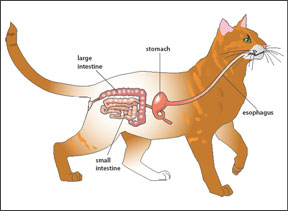73 Constipation Station: Megacolon in Cats
Mikayla Hjelden, Zoie Mueller, Grace McElmury
Objectives
- Understand the gastrointestinal tract structure of the cat
- Define signs/symptoms of megacolon in cats
- Demonstrate application of treatment plan
Introduction

The gastrointestinal tract of the cat starts with the mouth. This is where food is broken up. It then travels to the esophagus where it is pushed into the stomach. Cats have a simple stomach which means they have one stomach that uses digestive enzymes to break down their food. From the stomach, food moves into the small intestine. The small intestine has three parts: duodenum, jejunum, and ileum. All three parts function in absorbing nutrients from the food that was taken in. The next part of the gastrointestinal tract is the large intestine. The large intestine also has three parts: cecum, colon, and rectum. All three parts function in absorbing water from the food.
The parts of the gastrointestinal tract work together to take the nutrients and water out of the food that is being eaten by the cat to be utilized by the body. When one part of the tract is not working correctly then it can cause issues throughout the whole body.
X-ray view of the gastrointestinal tract in a cat:

Overview of Megacolon
Megacolon in cats is a disease in which the colon remains stretched out, increasing its size to 3-4x the normal diameter, because the muscles are unable to contract. Normally, colon contraction would move feces towards the rectum, an area where the feces sits until it exits the body. Instead, feces is unable to move into the rectum, and instead collects in the colon itself, leading to constipation. Megacolon describes this excessive buildup and size increase.
There can be many different causes of megacolon. These can include something that blocks the GI tract or a spinal cord injury, but, in most cats, the cause remains unknown. A veterinarian can determine if a cat has megacolon by talking to the owner about its symptoms, which can include weight loss, vomiting, a lack of appetite, and problems trying to poop. Dehydration is a common symptom in cats with megacolon, which can cause their poop to be very solid and become obstructed with in their colon. When making their diagnosis the veterinarian can feel the cat’s belly, as well as x-rays to look at what is going on inside the cat’s colon. Then, they can treat megacolon by giving medications or a specific diet to help the cat poop, giving the cat an enema along with intravenous fluid therapy, or by surgically removing the part of the colon that does not function.
Enemas are injectable fluids used to clean out or stimulate bowel movements in constipated cats. An enema is a thick syringe that is inserted into the rectum of the cat to help flush out the colon. There are different types of enemas that can be used for oil-retention, cleansing, or enema type solutions to help their poop move through the colon/rectum. These enemas should be administered slowly and manual manipulation of the poop may be needed to clear the obstruction.
Watch this video to review the importance of Megacolon
Application Activity
Knowledge Check

